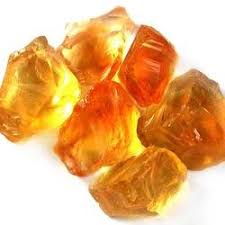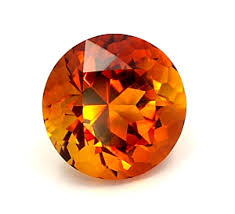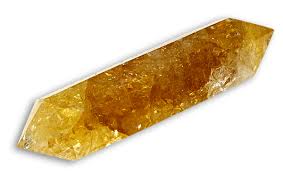Interesting facts about Citrine
Color ranges from pale yellow, to medium yellow, to medium-dark orange-yellow, to root beer color. Most Citrine on the market is actually a brownish variety of an Amethyst that has been heat treated to produce the bright yellow colors and darker stones with reddish tints. The pale yellow color stones are typically natural untreated stones. As the color ranges into medium-dark orange-yellow to Root Beer it is called Madeira Citrine. Citrine is heat sensitive, excessive heat could turn the stone colorless, an abrupt temperature change may fracture the stone. Chemicals that could attack this gem are hydrofluoric acids, ammonium fluoride, and alkalies. Sources for this gemstone are Brazil, Bolivia, and Madagascar.
Citrine, a member of the Quartz mineral family, is a Quartz whose color is probably caused by Iron traces.
Citrine's name is derived from the French Citrine for lemon, it might also come from the Latin ‘citrina’ that means yellow.
The term “citrine” was formally used only after 1556. Up until then, the stone had been known simply as yellow quartz (sounds much less glamorous, right?).
It is nearly impossible to tell cut citrine from the more expensive yellow topaz with the naked eye. Their main difference between the gems is in hardness, so have your gem testing tools handy.
Most citrines are actually heat treated amethysts or smoky quartz. The natural yellow colour of citrine is rather pale, but the heat-treated stones have deeper colour, sometimes with a slight reddish tint. I hope you did not get disappointed that the favourite citrine jewel of yours has in fact a heat-treated gem.

The largest citrine weighing 2258 carats originates from Brazil and is displayed at the Smithsonian in Washington. The gem is extremely large considering that the typical size used in jewellery isunder 25 carats.
From pastel yellows, to wonderful orange hues Citrine will fl atter many fashion-conscious pallets. Yellow hues are striking and are
symbolic of the sun, health, and vitality. Since it is plentiful in nature, it represents an incredible value for the person who appreciates.
its colour. It is available in a wide range of shapes and sizes, and it is a favorite choice of many jewelry designers.

Brazil is the main supplier of citrines. However, they are also found in Madagascar, Zambia, Namibia, Ural Mountains in Russia and in most countries where amethysts are found. Now I have another good reason to visit those countries.
Citrines can scratch relatively easy and need to be looked after. One should store citrine jewellery out of direct sunlight as the colour can sometimes permanently fade.
The Romans were thought to be the first to wear citrine, mostly as cameos or intaglios. The gem re-discovered its popularity during the Romantic period as it enhanced the beauty of gold jewellery. Nowadays, citrine jewellery is widely worn and loved, so the gallery with the latest honey-coloured jewels is coming up shortly.

Citrine is the birthstone for November and the traditional anniversary gemstone for the 13th year of marriage.
A tremendous amount of citrine that is available on the market today is heat-treated amethyst. Natural citrine is much lighter than the heat-treated material which is dark orange-brown to reddish-brown in color.
Chemical Composition: Silica (Silicon Dioxide) SiO2
Colors / Varieties: Yellow, Golden
Crystal System / Forms: Trigonal System
Hardness: 7
Specific Gravity: 2.63 - 2.68
Cleavage / Fracture: No distinct cleavage / conchoidal to uneven fracture.
Optic Character: Anisotropic, D.R.; Uniaxial positive. May exhibit a bull's eye optic figure (quartz rotates the plane of polarisation parallel to the c-axis).
Lustre: Vitreous.
Refractive Index / Birefringence: 1.544 - 1.553 / 0.009. Range: 1.535 - 1.560
Pleochroism: Yellow / Slightly paler yellow
Dispersion: 0.013

Magnification: Liquid and two phase, color zoning, negative crystals, zebra-stripe finger prints (structural), crystal inclusions, green fuchsite mica flakes / platelets in aventurine quartz, rutile / tourmaline needles in sagenitic quartz. Brazil law twinning is seen in natural quartz.
U.V. Fluorescence: Variable.
Spectrum: Not characteristic.
Cause of Color: Trace of Iron (Fe3+)
Treatment (Enhancement):
Coating: all colors, thin film of gold on colorless will give a blue color (aqua aura).
Colorless impregnation: with oil or resin to improve clarity.
Colored impregnation (dyeing): all colors, quartzite
Heat Treatment:
Light yellow to deeper yellow
Irradiation:
Citrine to amethyst









